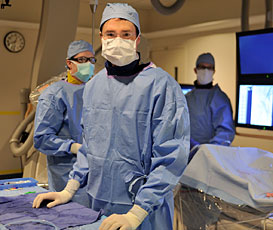Cardiac catheterization/intervention

Gill’s catheterization lab (sometimes called the cath lab) is on the second floor. This is where our cardiologists perform heart catheterizations. A catheterization lets us see inside your heart. It can also be used to place stents to open a blocked artery or for other procedures, such as a heart valve replacement.
Our doctors and nurses provide personal care in the safest environment possible. We work closely with your doctor so you and your family stay fully informed about your condition and the treatment.
Patient appointments
Request an appointment online or call one of the locations listed below.
Referrals
Health care providers, please visit our referral page to refer your patient to this service.
About heart catheterization
Catheters have changed the way heart disease is diagnosed and treated. Catheters let us use tiny instruments to repair heart problems from inside the blood vessels. We can often insert the catheter through a vein in your arm rather than through your groin.
Treatments that once called for open-heart surgery with large incisions and long recovery times can now be done with small incisions during an outpatient or short-term hospital visit. This means patients tend to have less pain and recover much more quickly.
For appointments or additional information, call 859-323-0013.
About the procedure
In cardiac catheterization (often abbreviated as "cath"), a very small catheter, or hollow tube, is advanced from a vessel in the groin (or sometimes the arm) up into the heart.
Once the catheter is in place, several diagnostic techniques may be used. The tip of the catheter can be placed into various parts of the heart to measure the pressure within the heart’s chambers. The catheter can be advanced into the coronary arteries and a dye injected into the arteries (coronary angiography or arteriography). With the use of fluoroscopy (a special type of X-ray), the doctor can identify blockages in the coronary arteries as the dye moves through them.
You will be somewhat awake during the procedure, although you will receive a small amount of sedating medication. A local anesthesia is used at the catheter entry site prior to the procedure.
Due to advances in knowledge, technology and techniques, cardiac cath is often performed on an outpatient basis, meaning that the procedure is done early in the day and you usually are able to go home the same day. Depending on what your doctor finds during the procedure, however, you may have to be admitted to the hospital.
Why Is cardiac catheterization done?
Your doctor may schedule you for a cardiac catheterization if you have recently experienced cardiac symptoms such as the following:
- Chest pain
- Shortness of breath
- Dizziness
- Fatigue
- A combination of any of these symptoms
A screening examination or test, such as an EKG or stress test, is usually done during the initial evaluation of symptoms such as those listed above. If such a test suggests a possibility of some type of heart disease that needs to be explored further, the doctor may determine that a cardiac cath is necessary.
Other reasons for the cath procedure include evaluation of myocardial perfusion (blood flow to the heart muscle) after heart attack, heart bypass surgery, coronary angioplasty (the opening of a coronary artery using a balloon or other method) or placement of a stent (a tiny expandable metal coil placed inside the artery to keep the artery open).
There may be other reasons for your doctor to recommend a cath procedure as well.
Cardiac catheterization is also used to detect and evaluate heart conditions or diseases, including the following:
- Coronary artery disease (CAD). This is the narrowing of the arteries caused by a buildup of fatty material within the walls of the arteries. This buildup causes the inside of the arteries to become rough and narrowed, limiting the supply of oxygen-rich blood to the heart muscle.
- Valvular heart disease. In order to keep the blood flowing forward during its journey through the heart, there are valves between each of the heart's pumping chambers. The tricuspid valve is between the right atrium and the right ventricle; the pulmonary (or pulmonic) valve is between the right ventricle and the pulmonary artery; the mitral valve is between the left atrium and the left ventricle; and the aortic valve is between the left ventricle and the aorta.
- If the heart valves become damaged or diseased, they may not function properly. Dysfunction of heart valves may be either stenotic (narrowed and/or stiff) or regurgitant (leaky). When one or more valves become stiff, or stenotic, the heart muscle must work harder to pump the blood through the valve.
Some reasons why heart valves become stenotic include infection (such as rheumatic fever or infections) and due to aging. If one or more valves become regurgitant, blood leaks backwards, meaning less blood is pumped forward. Cardiac catheterization is used to diagnose and evaluate the severity of valvular heart disease.
Why Choose Gill?
We have the ability to perform any and every procedure, but we only perform what is proven to improve our patients' well-being. We adhere to guidelines based on data collected by the American College of Cardiology to ensure our patients receive care and treatment that is truly best for their individual needs.
Expertise
Gill’s interventional cardiologists are highly experienced and nationally recognized in various areas of coronary, peripheral, carotid and structural heart procedures. That experience allows them to provide comprehensive care for even the most complex and advanced cardiac problems.
Compassion
We treat all patients with respect and compassion. At Gill, we hold our physicians, nurses and staff to the highest levels of professional and ethical behaviors. This is what we believe in and what you should expect from us.
Latest technology
The Gill cath laboratories are equipped with the most advanced technologies for imaging, cardiac support and advanced interventional techniques to provide the appropriate service for all patients, no matter what their needs are.
Innovative Research
Our interventional cardiologists are part of the most advanced research initiatives, making the latest treatments in cardiovascular medicine available to Kentuckians at the same time they’re being introduced to the rest of the country.
Teamwork
We offer a collaborative team effort to all of our patients. When dealing with complex medical conditions, patients require the contributions of more than one expert in the field of cardiovascular medicine. Our interventional physicians collaborate with other members of the Gill team who are nationally recognized experts in the fields of cardiac imaging, heart failure, transplantation, mechanical support, pulmonary hypertension, platelet biology and stem cell research.










